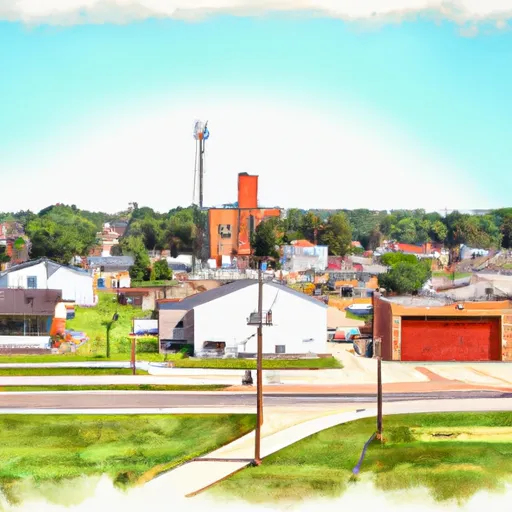-
 Snoflo Premium
Snoflo Premium
Get unlimited access to all our content
With no Ad interruptions! - Start Your Free Trial Login with existing account
Tekamah
Eden Index
Climate
7.7
•
Recreation
2.8
•
Community
2.0
•
Safeguard
4.6/10

Tekamah, Nebraska is a small city located in Burt County in the eastern part of the state. The climate in Tekamah is characterized by four distinct seasons. Summers are typically warm with temperatures averaging in the mid-80s Fahrenheit, while winters are cold with temperatures often dropping below freezing. Spring and fall bring mild temperatures and a mix of sunny and rainy days.
The hydrology constituents in Tekamah are primarily influenced by the nearby Missouri River. The river provides important water resources for the area, supporting agriculture and recreational activities such as fishing and boating. The river's influence also leads to fertile soil and lush vegetation in the surrounding areas.
Outdoor recreation opportunities in Tekamah are abundant. The city is surrounded by beautiful natural landscapes, including parks, forests, and lakes. Tekamah City Park is a popular spot for picnicking, walking trails, and enjoying nature. The nearby Snyder Bend Park offers camping, fishing, and boating facilities along the Missouri River. Outdoor enthusiasts can also explore the nearby DeSoto National Wildlife Refuge, which provides opportunities for bird-watching, hiking, and wildlife observation.
In summary, Tekamah, Nebraska offers a diverse climate, influenced by the Missouri River, and provides numerous outdoor recreation opportunities for visitors and residents alike.
What is the Eden Index?
The Snoflo Eden Index serves as a comprehensive rating system for regions, evaluating their desirability through a holistic assessment of climate health, outdoor recreation opportunities, and natural disaster risk, acknowledging the profound impact of these factors on livability and well-being.
Climate Health Indicator (CHI): 7.7
Tekamah receives approximately
767mm of rain per year,
with humidity levels near 83%
and air temperatures averaging around
10°C.
Tekamah has a plant hardyness factor of
5, meaning
plants and agriculture in this region thrive during a short period during spring and early summer. Most
plants will die off during the colder winter months.
By considering the ideal temperature range, reliable water supplies, clean air, and stable seasonal rain or snowpacks, the Climate Health Indicator (CHI) underscores the significance of a healthy climate as the foundation for quality living.
A healthy climate is paramount for ensuring a high quality of life and livability in a region, fostering both physical well-being and environmental harmony. This can be characterized by ideal temperatures, reliable access to water supplies, clean air, and consistent seasonal rain or snowpacks.
Weather Forecast
Streamflow Conditions
Missouri-Little Sioux
Area Rivers
Missouri-Little Sioux
Snowpack Depths
Missouri-Little Sioux
Reservoir Storage Capacity
Missouri-Little Sioux
Groundwater Levels
Recreational Opportunity Index (ROI): 2.8
The Recreational Opportunity Index (ROI) recognizes the value of outdoor recreational options, such as parks, hiking trails, camping sites, and fishing spots, while acknowledging that climate plays a pivotal role in ensuring the comfort and consistency of these experiences.
Access to outdoor recreational opportunities, encompassing activities such as parks, hiking, camping, and fishing, is crucial for overall well-being, and the climate plays a pivotal role in enabling and enhancing these experiences, ensuring that individuals can engage in nature-based activities comfortably and consistently.
Camping Areas
| Campground | Campsites | Reservations | Toilets | Showers | Elevation |
|---|---|---|---|---|---|
| Glenn Cunningham Lake | None | 1,130 ft | |||
| Eugene T. Mahoney State Park | 150 | 1,167 ft | |||
| Louisville Lakes State Rec Area | 300 | 1,032 ft | |||
| Wilson Island State Rec Area | 135 | 1,004 ft | |||
| Burchard Lake State Wildlife Area | 10 | 1,336 ft | |||
| Walnut Creek - Papillion | 45 | 1,124 ft | |||
| Weeping Water | 25 | 1,081 ft | |||
| Iron Horse Trail Lake | 11 | 1,132 ft |
Nearby Ski Areas
Catastrophe Safeguard Index (CSI):
The Catastrophe Safeguard Index (CSI) recognizes that natural disaster risk, encompassing floods, fires, hurricanes, and tornadoes, can drastically affect safety and the overall appeal of an area.
The level of natural disaster risk in a region significantly affects safety and the overall livability, with climate change amplifying these risks by potentially increasing the frequency and intensity of events like floods, fires, hurricanes, and tornadoes, thereby posing substantial challenges to community resilience and well-being.
Community Resilience Indicator (CRI): 2.0
The Community Resilience Indicator (CRI) recognizes that education, healthcare, and socioeconomics are crucial to the well-being of a region. The CRI acknowledges the profound impact of these elements on residents' overall quality of life. By evaluating educational resources, healthcare accessibility, and economic inclusivity, the index captures the essential aspects that contribute to a thriving community, fostering resident satisfaction, equity, and social cohesion.

